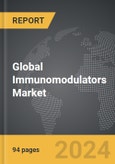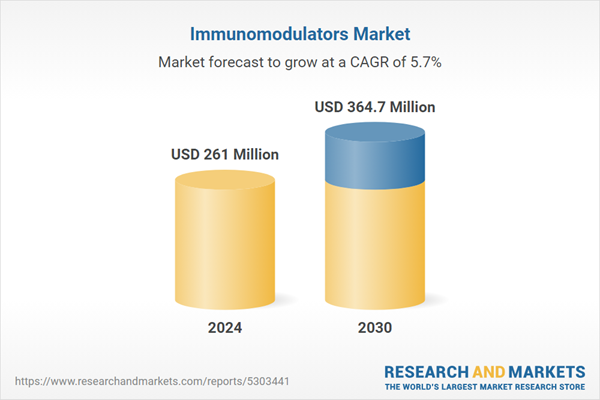The global market for Immunomodulators was valued at US$261.0 Million in 2024 and is projected to reach US$364.7 Million by 2030, growing at a CAGR of 5.7% from 2024 to 2030. This comprehensive report provides an in-depth analysis of market trends, drivers, and forecasts, helping you make informed business decisions. The report includes the most recent global tariff developments and how they impact the Immunomodulators market.
Segments: Product Type (Immunosuppressants, Immunostimulants); Application (Oncology, Respiratory, HIV, Other Applications).
Geographic Regions/Countries: World; United States; Canada; Japan; China; Europe (France; Germany; Italy; United Kingdom; Spain; Russia; and Rest of Europe); Asia-Pacific (Australia; India; South Korea; and Rest of Asia-Pacific); Latin America (Argentina; Brazil; Mexico; and Rest of Latin America); Middle East (Iran; Israel; Saudi Arabia; United Arab Emirates; and Rest of Middle East); and Africa.
The analysts continuously track trade developments worldwide, drawing insights from leading global economists and over 200 industry and policy institutions, including think tanks, trade organizations, and national economic advisory bodies. This intelligence is integrated into forecasting models to provide timely, data-driven analysis of emerging risks and opportunities.
Global Immunomodulators Market - Key Trends and Drivers Summarized
Why Are Immunomodulators Critical in Treating Immune-Mediated Diseases?
Immunomodulators are essential in managing a wide range of immune-mediated diseases, including autoimmune disorders, inflammatory diseases, and cancer. These agents work by modulating the immune system, either enhancing its response in cases like cancer and infections or suppressing it in autoimmune conditions such as rheumatoid arthritis, multiple sclerosis, and Crohn’s disease. Immunomodulators are divided into two main categories: immunosuppressants and immunostimulants. Immunosuppressants help control overactive immune responses, reducing inflammation and preventing tissue damage, while immunostimulants boost the immune system to fight infections and cancer. As the prevalence of immune-related conditions continues to rise, immunomodulators have become a cornerstone in modern therapeutic strategies, offering patients better management of chronic diseases and improving their quality of life.How Are Technological Advancements Shaping the Immunomodulators Market?
Technological advancements in biotechnology and pharmaceuticals are significantly expanding the capabilities and applications of immunomodulators. The development of biologics, including monoclonal antibodies and fusion proteins, has revolutionized the treatment of autoimmune diseases and cancers by targeting specific components of the immune system with greater precision and fewer side effects. Furthermore, gene therapy and RNA-based therapies are being explored as novel immunomodulatory approaches, offering potential for long-term disease control and even cures in some cases. Advancements in drug delivery systems, such as targeted nanoparticles and sustained-release formulations, are also improving the efficacy and safety of immunomodulators by ensuring precise delivery to affected tissues while minimizing systemic exposure. These innovations are broadening the therapeutic landscape for immunomodulators, enabling more personalized and effective treatments.How Do Market Segments Define the Growth of the Immunomodulators Industry?
Drug classes include immunosuppressants, immunostimulants, and biologics, with biologics being the fastest-growing segment due to their high specificity and effectiveness in treating complex immune-mediated diseases. Applications of immunomodulators span across autoimmune diseases, cancer, and organ transplantation, with autoimmune diseases holding the largest market share due to the rising incidence of conditions like rheumatoid arthritis, psoriasis, and multiple sclerosis. Distribution channels include hospitals, specialty pharmacies, and retail pharmacies, with hospitals accounting for the largest market share due to the need for close monitoring and administration of immunomodulatory therapies in clinical settings.What Factors Are Driving the Growth in the Immunomodulators Market?
The growth in the immunomodulators market is driven by several factors, including the increasing prevalence of autoimmune diseases and cancers, advancements in biologic therapies, and the growing demand for personalized medicine. As autoimmune and inflammatory diseases become more common, particularly in developed countries, the demand for effective immunomodulatory therapies continues to rise. Technological advancements, particularly in biologics and gene therapies, are expanding the treatment options available, offering better-targeted therapies with fewer side effects. Additionally, the growing focus on personalized medicine, which tailors treatments to individual patients based on their genetic and immunological profiles, is driving the adoption of novel immunomodulatory agents. Furthermore, the increasing investment in research and development by pharmaceutical companies and the introduction of new therapies in the pipeline are further contributing to market growth.Report Scope
The report analyzes the Immunomodulators market, presented in terms of units. The analysis covers the key segments and geographic regions outlined below.Segments: Product Type (Immunosuppressants, Immunostimulants); Application (Oncology, Respiratory, HIV, Other Applications).
Geographic Regions/Countries: World; United States; Canada; Japan; China; Europe (France; Germany; Italy; United Kingdom; Spain; Russia; and Rest of Europe); Asia-Pacific (Australia; India; South Korea; and Rest of Asia-Pacific); Latin America (Argentina; Brazil; Mexico; and Rest of Latin America); Middle East (Iran; Israel; Saudi Arabia; United Arab Emirates; and Rest of Middle East); and Africa.
Key Insights:
- Market Growth: Understand the significant growth trajectory of the Immunosuppressants segment, which is expected to reach US$209.8 Million by 2030 with a CAGR of a 6.1%. The Immunostimulants segment is also set to grow at 5.2% CAGR over the analysis period.
- Regional Analysis: Gain insights into the U.S. market, valued at $68.3 Million in 2024, and China, forecasted to grow at an impressive 8.7% CAGR to reach $83.2 Million by 2030. Discover growth trends in other key regions, including Japan, Canada, Germany, and the Asia-Pacific.
Why You Should Buy This Report:
- Detailed Market Analysis: Access a thorough analysis of the Global Immunomodulators Market, covering all major geographic regions and market segments.
- Competitive Insights: Get an overview of the competitive landscape, including the market presence of major players across different geographies.
- Future Trends and Drivers: Understand the key trends and drivers shaping the future of the Global Immunomodulators Market.
- Actionable Insights: Benefit from actionable insights that can help you identify new revenue opportunities and make strategic business decisions.
Key Questions Answered:
- How is the Global Immunomodulators Market expected to evolve by 2030?
- What are the main drivers and restraints affecting the market?
- Which market segments will grow the most over the forecast period?
- How will market shares for different regions and segments change by 2030?
- Who are the leading players in the market, and what are their prospects?
Report Features:
- Comprehensive Market Data: Independent analysis of annual sales and market forecasts in US$ Million from 2024 to 2030.
- In-Depth Regional Analysis: Detailed insights into key markets, including the U.S., China, Japan, Canada, Europe, Asia-Pacific, Latin America, Middle East, and Africa.
- Company Profiles: Coverage of players such as Abbott Laboratories, Amgen, Inc., Biogen Inc., Bristol-Myers Squibb Company, Eli Lilly and Company and more.
- Complimentary Updates: Receive free report updates for one year to keep you informed of the latest market developments.
Some of the 43 companies featured in this Immunomodulators market report include:
- Abbott Laboratories
- Amgen, Inc.
- Biogen Inc.
- Bristol-Myers Squibb Company
- Eli Lilly and Company
- F. Hoffmann-La Roche Ltd.
- Johnson & Johnson
- Merck & Co., Inc.
- Novartis AG
- Pfizer Inc.
Tariff Impact Analysis: Key Insights for 2025
Global tariff negotiations across 180+ countries are reshaping supply chains, costs, and competitiveness. This report reflects the latest developments as of April 2025 and incorporates forward-looking insights into the market outlook.The analysts continuously track trade developments worldwide, drawing insights from leading global economists and over 200 industry and policy institutions, including think tanks, trade organizations, and national economic advisory bodies. This intelligence is integrated into forecasting models to provide timely, data-driven analysis of emerging risks and opportunities.
What’s Included in This Edition:
- Tariff-adjusted market forecasts by region and segment
- Analysis of cost and supply chain implications by sourcing and trade exposure
- Strategic insights into geographic shifts
Buyers receive a free July 2025 update with:
- Finalized tariff impacts and new trade agreement effects
- Updated projections reflecting global sourcing and cost shifts
- Expanded country-specific coverage across the industry
Table of Contents
I. METHODOLOGYII. EXECUTIVE SUMMARY2. FOCUS ON SELECT PLAYERSIII. MARKET ANALYSISSOUTH KOREAREST OF ASIA-PACIFICARGENTINABRAZILMEXICOREST OF LATIN AMERICAIRANISRAELSAUDI ARABIAUNITED ARAB EMIRATESREST OF MIDDLE EASTIV. COMPETITION
1. MARKET OVERVIEW
3. MARKET TRENDS & DRIVERS
4. GLOBAL MARKET PERSPECTIVE
UNITED STATES
CANADA
JAPAN
CHINA
EUROPE
FRANCE
GERMANY
ITALY
UNITED KINGDOM
SPAIN
RUSSIA
REST OF EUROPE
ASIA-PACIFIC
AUSTRALIA
INDIA
LATIN AMERICA
MIDDLE EAST
AFRICA
Companies Mentioned (Partial List)
A selection of companies mentioned in this report includes, but is not limited to:
- Abbott Laboratories
- Amgen, Inc.
- Biogen Inc.
- Bristol-Myers Squibb Company
- Eli Lilly and Company
- F. Hoffmann-La Roche Ltd.
- Johnson & Johnson
- Merck & Co., Inc.
- Novartis AG
- Pfizer Inc.
Table Information
| Report Attribute | Details |
|---|---|
| No. of Pages | 94 |
| Published | April 2025 |
| Forecast Period | 2024 - 2030 |
| Estimated Market Value ( USD | $ 261 Million |
| Forecasted Market Value ( USD | $ 364.7 Million |
| Compound Annual Growth Rate | 5.7% |
| Regions Covered | Global |









